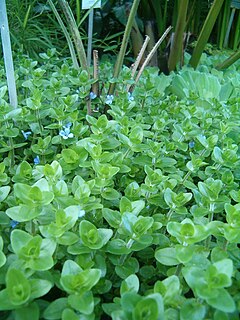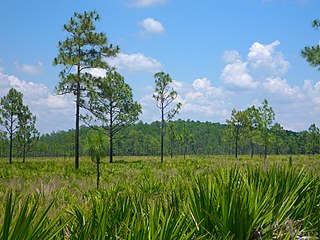
The south Florida cypress dome is a forested wetland plant community found in southern Florida, mostly in and around the Everglades and the Big Cypress National Preserve. They form in shallow depressions whose impervious substrates hold standing water for several months of the year. [1]

A wetland is a distinct ecosystem that is inundated by water, either permanently or seasonally, where oxygen-free processes prevail. The primary factor that distinguishes wetlands from other land forms or water bodies is the characteristic vegetation of aquatic plants, adapted to the unique hydric soil. Wetlands play a number of functions, including water purification, water storage, processing of carbon and other nutrients, stabilization of shorelines, and support of plants and animals. Wetlands are also considered the most biologically diverse of all ecosystems, serving as home to a wide range of plant and animal life. Whether any individual wetland performs these functions, and the degree to which it performs them, depends on characteristics of that wetland and the lands and waters near it. Methods for rapidly assessing these functions, wetland ecological health, and general wetland condition have been developed in many regions and have contributed to wetland conservation partly by raising public awareness of the functions and the ecosystem services some wetlands provide.

The Everglades is a natural region of tropical wetlands in the southern portion of the U.S. state of Florida, comprising the southern half of a large drainage basin and part of the neotropic ecozone. The system begins near Orlando with the Kissimmee River, which discharges into the vast but shallow Lake Okeechobee. Water leaving the lake in the wet season forms a slow-moving river 60 miles (97 km) wide and over 100 miles (160 km) long, flowing southward across a limestone shelf to Florida Bay at the southern end of the state. The Everglades experience a wide range of weather patterns, from frequent flooding in the wet season to drought in the dry season. The Seminole Tribe gave the large body of water the name Okeechobee meaning "River of Grass" to describe the sawgrass marshes, part of a complex system of interdependent ecosystems that include cypress swamps, the estuarine mangrove forests of the Ten Thousand Islands, tropical hardwood hammocks, pine rockland, and the marine environment of Florida Bay.

Big Cypress National Preserve is a United States National Preserve located in South Florida, about 45 miles west of Miami on the Atlantic coastal plain. The 720,000-acre (2,900 km2) Big Cypress, along with Big Thicket National Preserve in Texas, became the first national preserves in the United States National Park System when they were established on October 11, 1974. In 2008, Florida film producer Elam Stoltzfus featured the preserve in a PBS documentary.
Although the center of the depression is its deepest part, it is also where trees are the tallest and oldest. This gives these swamps a dome-like appearance and also their name. The stagnant water in the depressions is highly acidic. [1]
Pond cypress ( Taxodium ascendens ) is the most common tree in cypress domes. It is joined by the subtropical shrubs pond-apple ( Annona glabra ), cocoplum ( Chrysobalanus icaco ), and swamp bay ( Persea palustris ). Herbaceous plants include giant red bacopa ( Bacopa caroliniana ). The strangler fig ( Ficus aurea ) and the ghost orchid ( Dendrophylax lindenii ) are also found here. [1]

Taxodium ascendens, also known as pond cypress, is a deciduous conifer of the genus Taxodium, native to North America. Many botanists treat it as a variety of bald cypress, Taxodium distichum rather than as a distinct species, but it differs in ecology, occurring mainly in still blackwater rivers, ponds and swamps without silt-rich flood deposits. It predominates in cypress dome habitats.

Annona glabra is a tropical fruit tree in the family Annonaceae, in the same genus as the Soursop and Cherimoya. Common names include pond apple, alligator apple, swamp apple, corkwood, bobwood, and monkey apple. The tree is native to Florida in the United States, the Caribbean, Central and South America, and West Africa. It is common in the Everglades. The A. glabra tree is considered an invasive species in Sri Lanka and Australia. It grows in swamps, is tolerant of saltwater, and cannot grow in dry soil.

Chrysobalanus icaco, the cocoplum, paradise plum, abajeru or icaco, is found near sea beaches and inland throughout tropical Africa, tropical Americas and the Caribbean, and in southern Florida and the Bahamas. It is also found as an exotic species on other tropical islands, where it has become a problematic invasive. Although taxonomists disagree on whether Chrysobalanus icaco has multiple subspecies or varieties, it is recognized as having two ecotypes, described as an inland, much less salt-tolerant, and more upright C. icaco var. pellocarpus and a coastal C. icaco var. icaco. Both the ripe fruit of C. icaco, and the seed inside the ridged shell it contains, are considered edible.
It is distinguished from the similar southern coastal plain nonriverine cypress dome by the presence of tropical understory species. [1]
The southern coastal plain nonriverine cypress dome is a forested wetland community found in the southern Atlantic coastal plain, in the states of Alabama, Florida, Georgia, Louisiana, and Mississippi.















